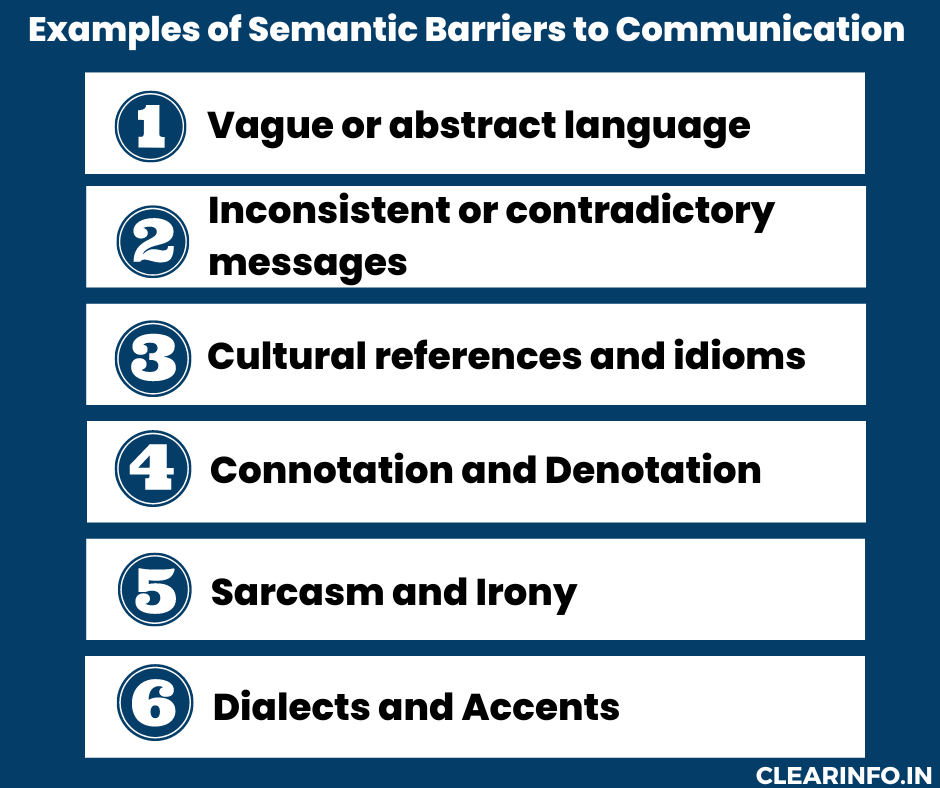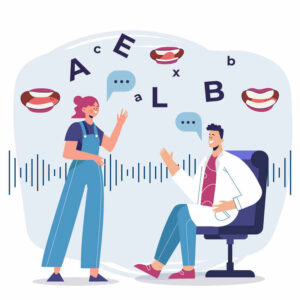Definition of semantic barriers of communication
“Semantic barriers of communication occur when individuals assign different meanings to words, phrases, or symbols used in a message. These barriers can impede understanding and lead to miscommunication or incomplete comprehension.”
(Source: Business Communication: Polishing Your Professional Presence by Barbara G. Shwom and Lisa Gueldenzoph Snyder)
What are the semantic barriers of communication?
Semantic barriers to communication are difficulties that arise as a result of differences in the interpretation and comprehension conveyed through language, symbols, and gestures. These barriers occur when there is a mismatch or confusion between the intended message and how it is perceived by the receiver.
Semantic barriers can be caused by various factors such as language differences, ambiguous or unclear communication, improper word choice, technical jargon, and lack of shared knowledge or understanding. These barriers can prevent effective communication, leading to misinterpretations, and a breakdown in the exchange of information and ideas.
Characteristics of semantic barriers:
- Subjectivity: Semantic barriers are subjective in nature, as they depend on the individual’s perception, interpretation, and understanding of the message.
- Context-dependency: The context in which communication takes place plays a crucial role in semantic barriers.
- Cultural and linguistic diversity: Semantic barriers are influenced by cultural and linguistic differences.
- Lack of feedback: Semantic barriers persist when there is a lack of feedback or a failure to seek clarification during the process of communication.
Understanding the characteristics of semantic barriers allows communicators to be aware of the potential challenges and take appropriate measures to overcome them.
Types of Semantic Barriers to Communication
1/ Ambiguity and multiple interpretations:
Ambiguity refers to situations where a word, phrase, or message can be understood in more than one way. It occurs when there is a lack of clarity in communication, leaving room for multiple interpretations. Ambiguity can arise due to various factors, such as vague language, unclear context, or the use of words with multiple meanings.
When a message is ambiguous, different individuals may interpret it differently based on their own understanding, experiences, or perspectives. This can lead to confusion, misunderstandings, and miscommunication.
For example, a sentence like “I saw her duck” can have two interpretations: seeing someone named “Her” physically ducking or witnessing a duck that belongs to “Her.”
Ambiguity can occur in both verbal and written communication. In verbal communication, it can be challenging to clarify ambiguity on the spot, especially if there are no opportunities for immediate feedback or clarification-seeking. In written communication, ambiguity can persist if the author fails to provide sufficient context or uses imprecise language.
2/ Jargon and technical language:
Jargon and technical language are specialized vocabularies used within specific professions, industries, or communities. While jargon and technical language can facilitate efficient communication within a specific group, they can pose significant semantic barriers in communication when used in interactions with individuals who are unfamiliar with the terminology.
When jargon and technical language are employed without considering the knowledge and background of the audience, communication breakdowns can occur. The receiver may struggle to understand the message due to a lack of familiarity with the terms, resulting in confusion and misunderstandings. This barrier is particularly prevalent when experts communicate with non-experts or when cross-disciplinary collaboration takes place.
For example, imagine a software developer discussing coding techniques with a marketing professional who has limited knowledge of programming. The use of technical jargon by the developer may leave the marketer unable to fully grasp the intended message. In this case, effective communication necessitates translating the technical language into simpler terms that the marketer can understand.
3/ Semantic noise in communication channels:
Semantic noise refers to any interference or distortion in the communication process that affects the accurate encoding, transmission, or decoding of a message. This noise can occur in various forms and disrupt the intended meaning of the communication.
Semantic noise can arise from different sources, including linguistic, technological, or environmental factors. Here are a few examples:
- Linguistic noise: This occurs when there are language barriers, such as differences in dialects, accents, or pronunciation, that limit clear understanding between individuals.
- Technological noise: Interference caused by glitches in communication tools, such as poor audio quality, distorted visuals, or interrupted transmission, can disrupt the reception of messages.
- Environmental noise: Background noise, distractions, or disturbances in the physical environment where communication takes place can impact the comprehension and interpretation of messages.
Semantic noise can lead to miscommunication, as it hampers the effective encoding or decoding of the message. It creates a barrier by preventing the accurate transfer of information from the sender to the receiver. For instance, if there is a lot of background noise during a phone conversation, important details or words might get lost, leading to misunderstandings.
4/ Misuse of words and improper word choice:
Effective communication relies on using words and phrases that accurately convey the intended meaning. However, the misuse of words or improper word choice can create significant barriers to understanding.
Misuse of words can occur in several ways, including:
- Incorrect usage: When words are used inappropriately or incorrectly, they can distort the intended message. For example, using “accept” instead of “except” or replacing “complement” with “compliment” can change the meaning of a sentence and potentially confuse the recipient.
- Ambiguous words: Certain words have multiple meanings or can be interpreted differently based on the context. Failing to clarify the specific meaning intended can lead to confusion. For instance, using the word “bank” without specifying whether it refers to a financial institution or the side of a river.
- Malapropisms: Using a word that sounds similar but has a completely different meaning, leads to unintended humor or confusion. For example, saying “He is a real genocide” instead of “He is a real genius.”
The following is an illustration of the misused word Bear Vs Bare creating misinterpretation

Improper word choice can also occur when a word is used inappropriately for a specific context or audience. This can happen when technical language or formal language is used in informal writing settings or when complex terms are used with individuals who lack the necessary background knowledge.
5/ Lack of context and non-verbal cues:
Context plays a crucial role in understanding the meaning of a message. The absence of context can make it challenging for the receiver to interpret the message correctly. For example, if someone receives an email with the subject line “Urgent,” without any additional information or context, it can be unclear what the email is about and how urgent it actually is.
Non-verbal cues, such as eye movement, gestures, tone of voice, and body language are crucial elements of effective communication. They provide additional information that complements the spoken or written words. When communication occurs solely through written text, such as in emails or text messages, non-verbal cues are lost, making it more challenging to measure the sender’s emotions or intentions accurately.
The lack of context and non-verbal cues can lead to misunderstandings. People may fill in the gaps with their assumptions, which can result in different interpretations of the same message. Additionally, misinterpretations can lead to conflicts, mistrust, or disengagement in interpersonal relationships and work settings.
7/ Vague or abstract language:
Vague or abstract language refers to the use of words or phrases that lack specific or concrete meaning. When communication relies heavily on vague or abstract language, it can create barriers to understanding.
Vague language can take various forms, such as using general terms, imprecise descriptions, or ambiguous expressions. It often leaves room for interpretation and can lead to confusion or miscommunication. For example, saying, “I need it as soon as possible” without specifying a deadline or timeframe can result in different interpretations of what “as soon as possible” actually means.
Abstract language, on the other hand, involves using words or concepts that are intangible, theoretical, or open to subjective interpretation. Abstract language can make it difficult for the receiver to grasp the intended meaning and can lead to misunderstandings. For instance, using terms like “success,” “happiness,” or “freedom” without providing clear definitions or contextual explanations can lead to different interpretations based on individual perspectives and experiences.
7/ Regional or dialectal variations in language:
Language is not static and can vary significantly based on regional, cultural, and dialectal differences. Regional or dialectal variations in language can pose challenges to effective communication, particularly when individuals from different regions or dialects interact.
Regional or dialectal variations involve differences in pronunciation, vocabulary, grammar, and even idiomatic expressions. These variations can create barriers to understanding, as individuals may struggle to comprehend unfamiliar accents, words, or sentence structures.
For example, the English language exhibits significant regional variations among countries like the United States, the United Kingdom, Canada, Australia, and other nations. These differences can include variations in spelling (e.g., “color” vs. “colour”), vocabulary (e.g., “truck” vs. “lorry”), or even pronunciation (e.g., “tomato”).
8/ Misunderstanding of idioms and metaphors:
Idioms and metaphors are common figures of speech used in languages. They add color and expressiveness to communication, but they can also create barriers when the listener or reader is not familiar with their meaning.
Idioms are phrases whose meaning is different from the literal meanings of the individual words they comprise. For example, the phrase “raining cats and dogs” means heavy rainfall, yet its meaning cannot be inferred by considering the individual words “raining,” “cats,” and “dogs” separately.
Metaphors, on the other hand, are expressions that refer to one thing by mentioning another, providing a deeper insight or comparison. For example, “time is money” is a metaphorical expression that suggests time is as valuable as money.
When idioms and metaphors are used in communication without considering the background and familiarity of the audience, misunderstandings can occur. The listener or reader may interpret the expressions literally, leading to confusion or misinterpretation of the intended message.
9/ Inappropriate use of humor or sarcasm:
Humor and sarcasm can be effective communication tools to engage and connect with others. However, when used inappropriately or without consideration for the audience, humor and sarcasm can create semantic barriers to effective communication.
Inappropriate use of humor refers to situations where jokes, sarcasm, or comedic remarks are misaligned with the context, cultural norms, or sensitivity of the individuals involved. This can lead to misunderstandings, offense, or even damage professional or personal relationships.
Sarcasm, in particular, involves using irony to mock or convey a different meaning from the literal interpretation. While sarcasm can be effective in certain situations, its misuse or overuse can result in confusion or hurt feelings.
Inappropriate humor or sarcasm can create barriers to effective communication in the following ways:
- Misinterpretation: The recipient may not grasp the intended humor or sarcasm, leading to a literal interpretation of the message and missing the intended meaning.
- Offense: Inappropriate humor or sarcasm may offend or hurt individuals who do not share the same sense of humor or are sensitive to certain topics.
- Breakdown of trust: Repeated use of inappropriate humor or sarcasm can weaken trust and credibility in communication, making it difficult to establish a positive and productive rapport with others.
10/ Limited vocabulary or language proficiency:
Limited vocabulary refers to a situation where individuals do not possess an extensive range of words to convey their intended message comprehensively. This can result in communication that is unclear or lacks the depth needed to express complex ideas.
Similarly, individuals with limited language proficiency in a particular language may face difficulties in understanding and responding to messages. They might encounter difficulties understanding elaborated sentence structures, idiomatic expressions, or technical jargon, which can result in confusion.
According to researchers, having a passive vocabulary of at least 3,000-word families (equivalent to approximately 5,000 words) is necessary to comprehend a significant portion of words on an average page of text. Furthermore, to enjoy reading leisurely, a minimum of 5,000-word families (around 8,000 words) is recommended.
Furthermore, limited vocabulary or language proficiency can hamper effective communication in various ways:
- Incomplete expression: Individuals with limited vocabulary may struggle to express themselves fully, leading to gaps in their communication and an inability to convey their thoughts or ideas effectively.
- Difficulty in comprehension: Individuals with limited language proficiency may find it challenging to understand messages from others, especially if they contain advanced vocabulary or complex sentence structures.
- Reliance on non-verbal cues: When faced with language barriers, individuals may rely more on non-verbal cues, such as gestures and facial expressions, to compensate for the gaps in communication.
Examples of semantic barriers in communication

Examples of semantic noise
- Inconsistent or contradictory messages: When verbal and non-verbal cues convey conflicting information, it can create semantic noise.
- Slang and colloquial expressions: While slang and colloquial expressions may be familiar to some individuals, they can be confusing or unclear to others, resulting in semantic noise.
- Cultural differences in communication styles: Cultural variations in communication styles can lead to semantic noise.
Example of semantic interference:
- Misinterpretation of vocabulary: When the meaning of specific words or terms is misunderstood, semantic interference can occur.
- Noise in communication channels: External distractions or interruptions during communication can introduce semantic interference.
- Emotional interference: Sentimental barriers, such as anger or stress, can interfere with the accurate interpretation of a message.
Example of semantic misunderstanding
- For instance, if someone says, “Please close the door,” but doesn’t specify which door, it can result in semantic misunderstanding.
- For example, the words “bear” (referring to the animal) and “bare” (meaning uncovered) can be easily confused if not used in the appropriate context.
- A statement like “She’s really assertive” may be interpreted positively by one person but negatively by another, depending on their understanding and perspective of the word “assertive.”
Semantic communication example
- Conversation: When two or more individuals engage in a verbal discussion, they rely on semantic communication to convey their thoughts, ideas, and emotions.
- Presentations and speeches: When delivering presentations or speeches, individuals utilize semantic communication to articulate their ideas effectively.
- Advertising and marketing messages: In advertising and marketing, semantic communication is crucial to convey the desired message to consumers.
How to overcome semantic barriers of communication?
Employing the right strategies to overcome semantic barriers can enhance understanding, promotes clarity, and facilitates effective communication across various contexts and diverse audiences. Some of the common ways to overcome these barriers include:
1/ Using plain language and avoiding jargon:
To overcome the semantic barrier of jargon and technical language, using plain language becomes crucial. Plain language refers to clear and straightforward communication that avoids complex vocabulary, jargon, or technical terms. By employing plain language, communicators can enhance comprehension and reduce semantic barriers, allowing for effective and accessible communication.
2/ Providing context and using appropriate examples:
Providing context around the message helps recipients understand the background, circumstances, or reasons behind the communication. Context enables a clearer interpretation of the message’s meaning and minimizes ambiguity. Additionally, using relevant and appropriate examples can further illustrate the points being made, making the message more relatable and understandable.
3/ Adapting communication to different cultural and linguistic backgrounds:
Adapting communication to different cultural and linguistic backgrounds recognizes and respects the diversity of individuals’ cultural and language backgrounds. It involves being sensitive to cultural nuances, customs, and communication styles. By adapting communication approaches, such as adjusting language use, tone, and gestures, communicators can bridge cultural and linguistic gaps, promoting effective cross-cultural communication.
4/ Utilizing visual aids and non-verbal communication cues:
Utilizing visual aids involves incorporating visual elements, such as charts, diagrams, or presentations, to supplement verbal communication. Visual aids can enhance understanding, especially when complex or abstract information is being conveyed. Non-verbal cues in communication, including hand gestures, eye movement, and body language, hold great importance in expressing meaning and emotions. Paying attention to and utilizing these cues can augment the effectiveness of communication and overcome semantic barriers.
Semantic barriers in business communication
The semantic barriers in business communication refer to obstacles that arise due to the distortion of messages exchanged within the business context. These barriers can slow down effective communication and lead to inefficiencies, errors, and even conflicts in business operations. Several factors contribute to semantic barriers in business communication:
1/ Differences in organizational language and jargon: Different departments or teams within a company may develop their own jargon and terminologies. This internal language can create confusion when employees from different areas collaborate, leading to semantic barriers.
2/ Noise in communication channels: In a busy business environment, there may be distractions, interruptions, or technological issues that interfere with the transmission or reception of messages. Such noise can prevent the accurate exchange of information and contribute to semantic barriers.
3/ Lack of feedback and clarification-seeking: Failing to seek clarification or provide opportunities for feedback can perpetuate semantic barriers in business communication. Without an active effort to seek understanding and address potential misunderstandings, an effective communication process may be hindered.
Recognizing and addressing semantic barriers in business communication is crucial for fostering a productive and collaborative work environment. Employing strategies such as using clear and plain language, providing context, and clarification-seeking can help overcome these barriers and enhance the overall business communication process in a business setting.
Semantic barriers to communication skills
The semantic barriers to communication skills involve difficulties in conveying or understanding messages due to factors such as language differences, misinterpretation of words or phrases, ambiguity, cultural variations, and improper use of language. These barriers can impact various communication skills, including speaking skills, listening skills, reading skills, and writing skills. They can block the accurate transmission and reception of messages, leading to misunderstandings, miscommunications, and ineffective communication overall.
Effective communication skills require clear and concise expression of thoughts and accurate interpretation of meaning. Semantic barriers can arise when the recipient does not accurately grasp the intended meaning of a message, resulting in a breakdown of communication.
Impact of Semantic Barriers on Communication
Semantic barriers in communication can have significant consequences on the effectiveness and outcomes of interpersonal and organizational interactions. Let’s explore the various impacts of semantic barriers on communication:
1/ Reduced Clarity and Precision in Conveying Messages:
Semantic barriers restrain the ability to convey messages with clarity and precision. When individuals struggle to articulate their thoughts effectively or encounter language-related obstacles, the message may lose its intended meaning. As a result, communication becomes less efficient, and important information may be lost or overlooked.
2/ Conflict and Tension in Interpersonal Relationships:
Semantic barriers can contribute to interpersonal conflicts and tension. Misunderstandings and misinterpretations can lead to disagreements, frustration, and strained relationships. People may feel unheard or misrepresented, fostering a negative atmosphere that limits collaboration and effective communication.
3/ Inefficiency in Business and Organizational Communication:
In a business or organizational context, semantic barriers can result in inefficiency. When communication is unclear or ambiguous, it may lead to mistakes, delays, or the need for additional clarification. Productivity can suffer as a result, and valuable time and resources may be wasted in addressing misunderstandings.
4/ Barriers to Effective Collaboration and Teamwork:
Effective collaboration and teamwork heavily rely on clear and seamless communication. Semantic barriers can prevent collaboration by creating difficulties in exchanging ideas, coordinating efforts, and understanding each team member’s contributions. This can lead to disjointed teamwork and slow down progress toward shared goals.
Role of Semantics in Communication
The role of semantics in communication is to facilitate the understanding and interpretation of meaning in messages. Semantics refers to the study of meaning in language and how words, phrases, and symbols convey specific concepts or ideas. It plays a crucial role in effective communication by enabling individuals to express their thoughts and intentions and allowing recipients to accurately understand and interpret those messages.
Here are key aspects of the role of semantics in communication:
- Meaning construction: Semantics helps in constructing and conveying meaning in communication. It involves the selection and use of words, phrases, and symbols that carry specific meanings and evoke desired interpretations.
- Precision and clarity: Semantics aids in achieving precision and clarity in communication. It enables communicators to choose words and expressions that accurately convey their intended meaning.
- Contextual relevance: Semantics takes into account the context in which communication occurs. It acknowledges that words and phrases can possess diverse meanings based on the context in which they are employed. By considering the context, communicators can convey messages that are appropriate and relevant, enhancing the accuracy of interpretation.
By understanding the role of semantics in communication, individuals can utilize language effectively, choose appropriate words, and promote shared understanding.
Difference between semantic and physical barriers
The below table provides a concise comparison between semantic barriers and physical barriers, highlighting their differences in terms of their nature, examples, causes, impact, and methods of overcoming them.
Semantic Barriers | Physical Barriers |
Related to the interpretation and understanding of meaning in communication. | Related to the physical environment and conditions of communication. |
Examples include ambiguity, jargon, language differences, and lack of context. | Examples include noise, distance, poor acoustics, and visual obstructions. |
Arise from misinterpretation, cultural variations, and improper word use. | Arise from external factors such as noise, distractions, or geographical separation. |
Impact the accuracy and effectiveness of communication. | Impact the transmission and reception of messages. |
Can be overcome through clarification, active listening, and adaptation to cultural differences. | Can be overcome by minimizing noise, improving technology, and adjusting the physical environment. |
Addressing semantic barriers enhances understanding and promotes shared meaning. | Addressing physical barriers improves the quality and accessibility of communication. |
Further Reading: How to overcome physical barriers in communication
Difference between semantic and syntactic barriers to effective communication
Semantic Barriers | Syntactic Barriers |
Related to the meaning and interpretation of words, phrases, and symbols in communication. | Related to the structure, grammar, and arrangement of words and sentences in communication. |
Examples include ambiguity, jargon, cultural differences, and misuse of words. | Examples include incorrect sentence structure, grammar errors, and improper word order. |
Arise from differences in understanding, interpretation, and context. | Arise from violations of grammar rules and syntactic conventions. |
This can lead to miscommunication, misunderstandings, and inaccurate interpretation of messages. | This can lead to confusion, difficulty in comprehension, and incorrect understanding of messages. |
Overcoming semantic barriers involves clarification, providing context, and using plain language. | Overcoming syntactic barriers involves using proper grammar, sentence structure, and clear communication. |
Focuses on conveying accurate meaning and achieving shared understanding. | Focuses on constructing grammatically correct sentences and conveying information effectively. |
Difference between the semantic and linguistic barrier
Semantic Barriers | Linguistic Barriers |
Related to the interpretation and understanding of meaning in communication. | Related to language-specific issues and differences in linguistic systems. |
Arise from misinterpretation, lack of shared meaning, and improper use of words. | Arise from differences in language structure, grammar, vocabulary, and syntax. |
Can lead to misunderstandings, confusion, and inaccurate interpretation of messages. | Can lead to difficulties in comprehension, limited vocabulary, and challenges in expressing ideas effectively. |
Overcoming semantic barriers involves clarification, providing context, and promoting shared understanding. | Overcoming linguistic barriers involves language learning, translation, interpretation, and adapting communication to different languages. |
Focuses on accurate interpretation and understanding of meaning in communication. | Focuses on linguistic aspects such as language structure, grammar, vocabulary, and language proficiency. |
Difference between cross-cultural barriers and semantic barriers
Cross-Cultural Barriers | Semantic Barriers |
Arise from differences in cultural norms, values, beliefs, and communication styles between individuals from different cultures. | Arise from the interpretation and understanding of meaning in communication. |
Impact communication by leading to misinterpretation, misunderstandings, and conflicts due to cultural differences. | Impact communication by causing confusion, inaccuracies, and lack of clarity in conveying meaning. |
Require cultural sensitivity, awareness, and adaptation to different communication styles to overcome them. | Require clarification, provide context, and promote shared understanding to overcome them. |
Focus on bridging cultural gaps, fostering cultural intelligence, and promoting effective intercultural communication. | Focus on accurately conveying and interpreting meaning, enhancing clarity, and reducing ambiguity in communication. |
Further Reading: How to overcome cross-cultural communication barriers
Frequently Asked Questions
Q1) What are examples of semantic barriers?
Ans: Semantic barriers in communication manifest in various ways and can limit the effective exchange of information and ideas. Ambiguity is a common semantic barrier example where a message can be interpreted in multiple ways, leading to confusion and misinterpretation.
Q2) What are the 4 semantic barriers of communication?
Ans: The four Semantic barriers in communication include ambiguity, jargon and technical language, cultural and language differences, and misuse of words. Addressing these barriers is vital for clarity and understanding.
Q3) What is semantic communication?
Ans: Semantic communication refers to the process of conveying meaning and understanding through the use of symbols, signs, and language. It focuses on the accurate interpretation and comprehension of messages, ensuring that the intended meaning is effectively transmitted and received.
Q4) What is a semantic barrier also called?
Ans: A semantic barrier is also commonly referred to as a denotive barrier and a connotative barrier.
Q5) Which is considered the semantic in formal communication?
Ans: In formal communication, clarity and precision in conveying meaning are highly valued. Therefore, using semantic strategies that promote accurate interpretation and shared understanding is crucial.
Q6) Are semantic barriers and language barriers are same in terms of communication?
Ans: While there are similarities between semantic barriers and language barriers, they are not exactly the same in terms of communication.



